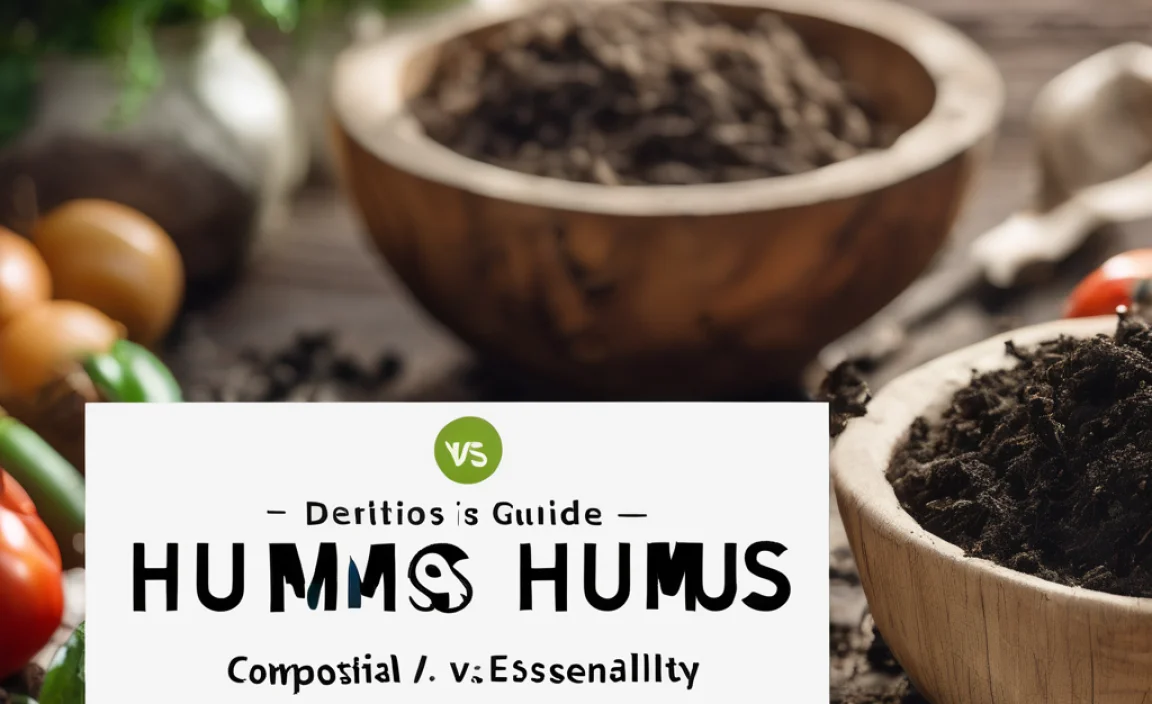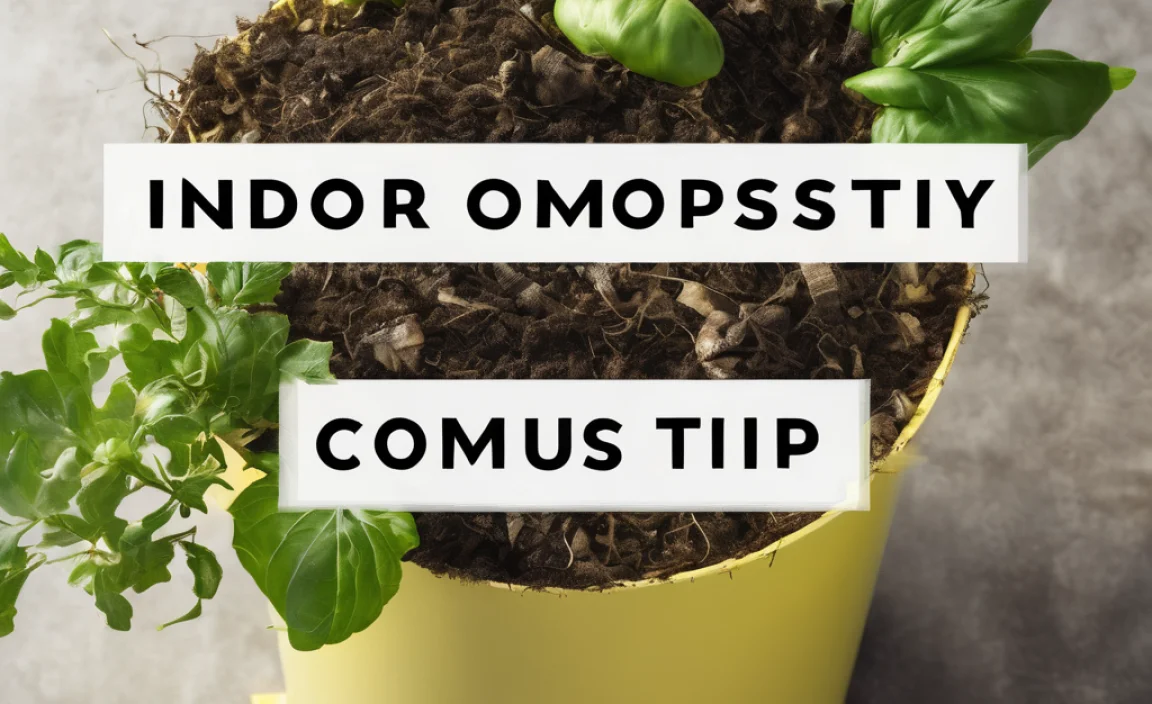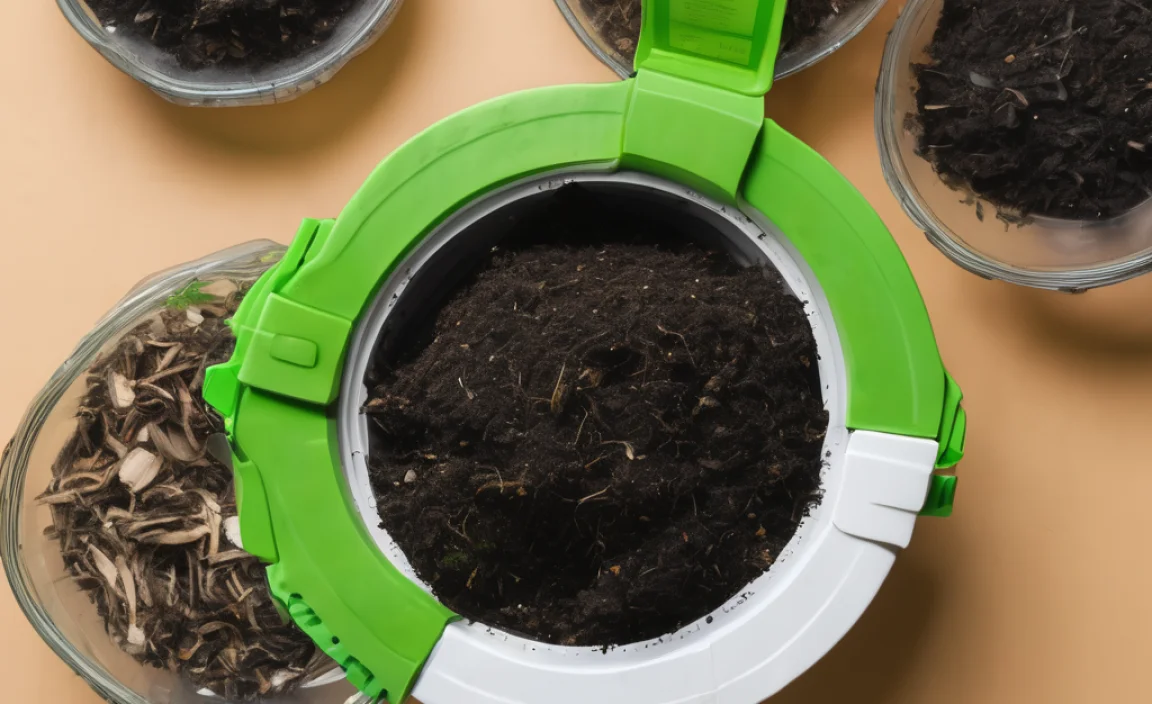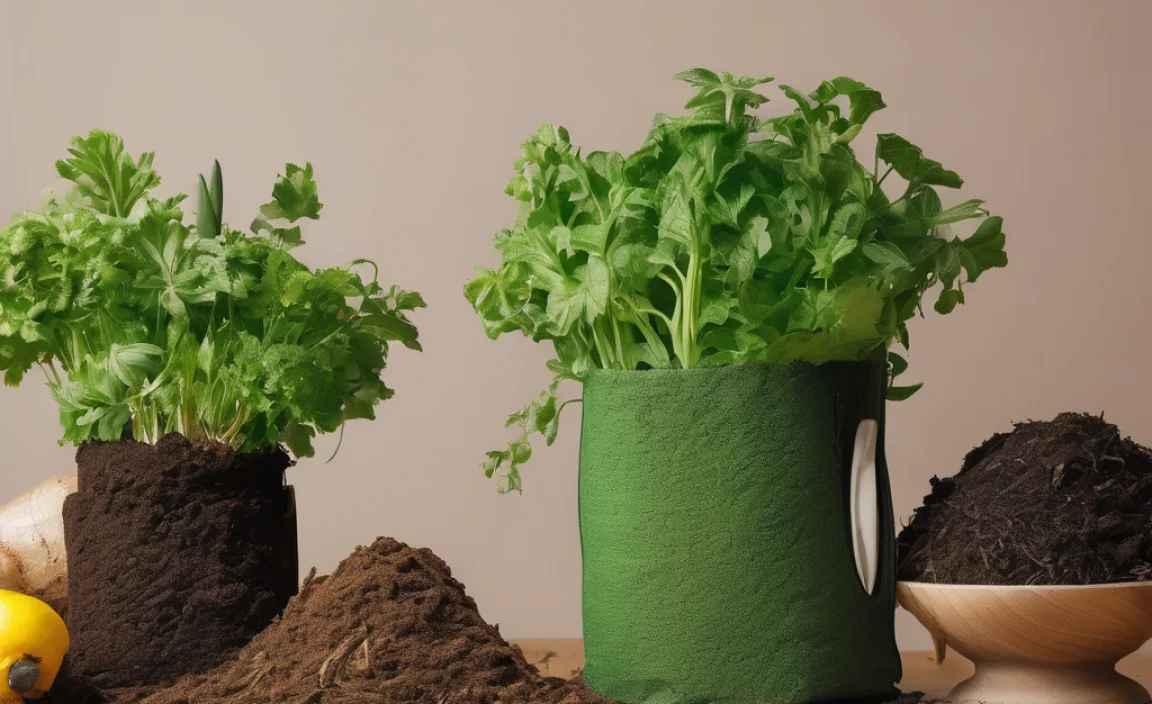Ever wondered how to turn your kitchen scraps and garden waste into garden gold? It can feel like a puzzle, especially when you’re just starting out. But don’t worry, we’re here to help! This guide will walk you through everything you need to know about compost tumblers, making it simple and fun. We’ll cover what they are, why they’re fantastic for UK gardens, and how to pick the perfect one for you. Let’s get composting!
Compost Tumbler UK: Your Essential Guide to Easy Composting

Hello there! Troy D Harn here, your friendly guide to making home and garden projects a breeze. If you’ve ever looked at your food scraps and wondered, “Can this really become something useful for my garden?”, the answer is a resounding YES! And if you’re in the UK and curious about the best way to do it, you’ve landed in the right spot. Today, we’re diving deep into the world of the compost tumbler – a clever contraption that makes composting simpler, faster, and way less messy than you might imagine. Forget the smelly, slow piles of the past; tumblers are here to revolutionize your recycling game.
What Exactly is a Compost Tumbler?
Think of a compost tumbler as a self-contained composting bin that you can (you guessed it!) tumble. Instead of a static pile, it’s usually a barrel or drum mounted on a stand or frame. This design allows you to easily turn the compost inside by rotating the drum. This tumbling action is the secret sauce! It aerates the compost, mixes the ingredients, and speeds up the decomposition process significantly. No more digging through a big pile with a fork – just a few turns every few days, and you’re well on your way to creating nutrient-rich compost for your flower beds and vegetable patches.
Why Choose a Compost Tumbler for Your UK Garden?
The UK climate can be… well, a bit damp and sometimes cool. This can slow down traditional composting a bit. Compost tumblers offer a brilliant solution for several reasons, especially for us in the UK:
- Faster Compost: The tumbling mixes everything and introduces air, which is super important for the tiny microbes that do the composting work. This means you can often get finished compost in as little as four to eight weeks, compared to six months or more with a static bin.
- Neater and Tidier: No open piles means less mess and fewer smells. They’re great for smaller gardens or balconies where space and aesthetics matter. Most are designed to look quite smart, too!
- Pest Deterrent: The enclosed nature of a tumbler makes it much harder for pests like rats or foxes to get to your compost. This is a big plus for many UK gardeners.
- Moisture Control: While the UK is known for rain, compost needs the right amount of moisture – not too wet, not too dry. Tumblers help contain moisture better than open piles, and some even have drainage systems.
- Easy to Use: Spinning a drum is much easier than forking a large, heavy compost heap. This makes it perfect for anyone who might struggle with heavier physical tasks.
Types of Compost Tumblers Available in the UK
When you start looking, you’ll see a few main types of compost tumblers. They generally fall into a few categories based on their design and how they work:
Single-Chamber Tumblers
These are often the most affordable and simplest option. They are typically a single drum that you fill up. Once it’s full, you start tumbling it. The catch? You can’t add new scraps while it’s actively composting. So, you have to let one batch finish before adding more. This is great if you don’t produce a huge amount of waste or if you’re happy to wait for a batch to be ready.
Dual-Chamber Tumblers
These are super popular because they solve the “can’t add more” problem. A dual-chamber tumbler has two separate compartments. You fill one side with fresh scraps. Once that side is full, you start tumbling it. While that batch is composting, you can start filling the second chamber with your new kitchen and garden waste. This means you always have a place to put your scraps, and you’ll have one chamber finishing up while the other is starting. This continuous flow makes for a steady supply of compost.
Batch vs. Continuous Tumblers
This is similar to single vs. dual-chamber. A batch tumbler is designed for one load at a time – you fill it, compost it, empty it, and start again. A continuous tumbler (like most dual-chamber models) allows you to keep adding new material while other material is composting. For most UK households with regular waste, a continuous or dual-chamber model is the most practical choice.
Stationary vs. Rotating Designs
Most tumblers we’re talking about here are designed to rotate. However, some bins might be called tumblers but have a stationary base with a mechanism to turn a drum within it. The key is that the compost inside is agitated and aerated. The barrel-style ones that you spin or tilt are the most common type found in UK gardens.
Key Features to Look For in a UK Compost Tumbler
When you’re browsing for your perfect tumbler, here are some key things to keep an eye on:
- Material: Most are made from UV-stabilized recycled plastic. This is durable, weather-resistant, and good for the environment. Look for sturdy construction that won’t warp or crack easily in the British weather.
- Capacity: Tumblers come in various sizes, usually measured in litres. A typical household might need something between 70 and 200 litres. Consider how much kitchen and garden waste you produce. Dual-chamber models often offer more total capacity as they’re designed for continuous use.
- Ease of Turning: Some tumblers are easier to spin than others. Look for models with a good handle or a design that allows for effortless rotation, even when full. Some models have geared mechanisms that make turning easier.
- Aeration: Good compost needs air. Check if the tumbler has plenty of ventilation holes. These allow oxygen to reach the composting materials, which is crucial for fast and efficient decomposition and preventing nasty odours.
- Drainage: Compost should be moist like a wrung-out sponge, not soggy. Some tumblers have drainage holes or a way to manage excess moisture, which is handy, especially in the often-damp UK climate.
- Assembly: Most tumblers come flat-packed. Check reviews or product descriptions for how easy they are to put together. You don’t want to spend hours wrestling with components.
- Price: Costs can vary widely. Simple single-chamber models might start around £80-£150, while larger, dual-chamber models can range from £150 to £300 or more.
How to Choose the Right Compost Tumbler for Your Needs
To help you make the best choice, let’s break down what might suit you best:
| Your Situation | Recommended Tumbler Type | Key Considerations | Why it Suits You |
|---|---|---|---|
| Small household, minimal waste, beginner | Single-Chamber Tumbler | Smaller capacity (e.g., 70-100L), simple design, budget-friendly | Easy to manage, less initial investment, less overwhelming for starting out. |
| Medium to large household, regular waste | Dual-Chamber Tumbler | Larger capacity (e.g., 140-200L+ total), continuous composting feature | Keeps up with waste production, constant supply of compost. |
| Busy gardener, wants compost fast | Dual-Chamber Tumbler | Good aeration, easy to turn frequently | Speeds up the process for quick harvests of compost. |
| Limited mobility or strength | Dual-Chamber Tumbler with easy-turn mechanism | Lightweight drum when not full, geared handle, good balance | Reduces physical effort required for turning. |
| Worried about pests/odours | Any well-sealed Tumbler | Secure lid, good aeration but not gaping holes | Enclosed design keeps unwanted visitors out and smells contained. |
Setting Up and Using Your Compost Tumbler in the UK
Once you’ve got your tumbler, it’s time to get it going! It’s pretty straightforward.
Step 1: Choose the Perfect Spot
Find a level spot in your garden that gets a good mix of sun and shade – ideally, a bit of sun to help warm it up and a bit of shade to prevent it from drying out too quickly. Accessibility is key, so make sure you can easily get to it with your kitchen scraps and garden waste, and that you have space to turn it. A spot near your kitchen door or vegetable patch is usually ideal.
Step 2: Gather Your Ingredients (The “Greens” and “Browns”)
Composting is all about balance. You need a mix of nitrogen-rich “greens” and carbon-rich “browns.”
- Greens (Nitrogen-rich): Fruit and vegetable scraps, coffee grounds, tea bags, grass clippings, plant trimmings. These add moisture and nutrients.
- Browns (Carbon-rich): Dry leaves, shredded cardboard (non-glossy), shredded newspaper, straw, small twigs, sawdust. These add bulk and help with airflow.
A good starting mix is roughly 1 part green to 2 or 3 parts brown. Don’t overthink it too much; you can adjust as you go.
Step 3: Start Filling Your Tumbler
You can start adding your greens and browns. Chop larger items into smaller pieces as this helps them break down much faster. Aim to add a layer of browns to the bottom first. Then, as you add kitchen scraps (greens), try to cover them with a layer of browns to help manage moisture and prevent any potential odours.
What NOT to compost in a tumbler:
- Meat, fish, dairy products, or oily foods (these can attract pests and cause bad smells).
- Diseased plants.
- Weeds that have gone to seed (unless you are sure your compost gets very hot, which is unlikely in most home tumblers).
- Pet waste (from dogs or cats).
- Large woody branches.
- Anything that cannot be composted, like plastic or metals.
Step 4: The Tumbling Action – How Often and How Much?
This is where the magic happens! Once you’ve added some materials, give the tumbler a good spin. How often you turn it depends on how quickly you want compost and how much effort you want to put in. Here’s a common guide:
- For Faster Compost (4-8 weeks): Turn the tumbler 4-5 times every 2-3 days.
- For Regular Compost (8-12 weeks): Turn the tumbler 2-3 times every week.
- For Slower, Less Effort Compost: Turn it once a week.
You’ll know you’re doing it right if the contents start to heat up a bit in the centre. This is a sign that the microbes are hard at work!
Step 5: Monitoring Moisture and Aeration
Your compost should be moist like a wrung-out sponge. If it’s too dry, add a little water (gently, perhaps when turning). If it’s too wet, add more dry brown materials like shredded cardboard or leaves. The tumbling action itself helps with aeration, but ensuring a good mix of greens and browns is also key.
Step 6: Harvesting Your Compost
The compost is ready when it looks dark, crumbly, and smells earthy. You shouldn’t be able to recognise the original materials you put in. How you harvest depends on your tumbler. You’ll usually need to open a hatch or door at the bottom. For dual-chamber tumblers, you’ll harvest from one side while continuing to fill the other.
It’s a good idea to let the finished compost cure for a week or two in a separate pile or bin before using it in your garden. This helps it stabilise.
Tips for Successful Composting with a Tumbler in the UK
Here are a few extra tips to make your composting journey smoother:
- Start Small: Don’t overload your tumbler right away. Fill it gradually.
- Chop it Up: Smaller pieces decompose significantly faster.
- Keep the Balance: Aim for that green/brown mix. Too much green can lead to sogginess and smells; too much brown means slow decomposition.
- Be Patient: Even with a tumbler, composting takes time. Don’t get discouraged if it’s not ready instantly.
- Check the Weather: In very hot, dry spells, you might need to add a little water. In prolonged wet periods, you might add extra browns to absorb moisture.
- Understand Aeration: The turning is vital. Make sure you’re giving it a good spin regularly.
Troubleshooting Common Composting Issues with Tumblers
Even with a tumbler, you might run into a few hiccups. Here’s how to fix them:
- Problem: Smelly Compost (like rotten eggs or ammonia)
- Cause: Too much nitrogen (greens) or too wet. Not enough air.
- Solution: Add more brown, carbon-rich materials (shredded cardboard, dry leaves). Turn the tumbler more frequently and thoroughly to increase aeration. Ensure any drainage holes aren’t blocked.
- Problem: Compost is Not Heating Up or Decomposing
- Cause: Too dry, not enough nitrogen (greens), or not enough active material.
- Solution: Add some water and mix well (turn the tumbler). Add more nitrogen-rich green materials. You might need a larger volume of material to kickstart the heating process – sometimes a tumbler needs at least a third to half full to get going properly.
- Problem: Pests (e.g., fruit flies, rodents)
- Cause: Adding forbidden items like meat, dairy, or oily foods. Compost is too wet and exposed scraps are visible.
- Solution: Only add approved compostable items. Always cover fresh kitchen scraps with a layer of brown material. Ensure the tumbler lid is secure. For rodents, ensure your tumbler is rodent-proof (most are).
- Problem: It’s too Hard to Turn
- Cause: Tumbler is overfilled, or the mechanism isn’t smooth.
- Solution: Don’t fill it beyond its recommended capacity. Some lightweight models can be a bit tricky when very full. Consider emptying some material, turning, and then refilling. Check that the turning mechanism is clean and clear of debris.
Compost Tumblers vs. Other Composting Methods in the UK
It’s useful to see how tumblers stack up against other popular composting methods:
1. Traditional Open Compost Heaps/Bins
Pros: Can handle large volumes, can be very cheap or free to set up, good for bulky garden waste.
Cons: Slower to break down, can be messy, more prone to pests and odours, requires more physical effort to turn/manage.
When a Tumbler is Better: If you want faster compost, a tidier garden, less effort, and better pest control.
2. Wormeries (Vermicomposting)
Pros: Excellent for kitchen scraps, produces high-quality “worm castings” fertiliser, can be used indoors or on balconies.
Cons: Cannot handle large volumes of garden waste, requires specific conditions (temperature, moisture), worms can be sensitive.
When a Tumbler is Better: If you produce a lot of mixed waste (both kitchen and garden), want a faster process, and don’t want to manage live worms.
For many UK gardeners, especially those with limited space or who want a more hands-off, faster approach, a compost tumbler often hits the sweet spot.
Environmental Benefits of Composting in the UK
Composting, whether in a tumbler or another method, is fantastic for the environment. In the UK, an estimated one-third of household waste is food waste, and much of this could be composted instead of going to landfill. When organic waste goes to landfill, it decomposes anaerobically (without air), producing methane, a potent greenhouse gas. By composting your waste, you:
- Reduce Landfill Waste: Lessening the burden on UK landfill sites
.lwrp.link-whisper-related-posts{
margin-top: 40px;
margin-bottom: 30px;
}
.lwrp .lwrp-title{}.lwrp .lwrp-description{
}
.lwrp .lwrp-list-container{
}
.lwrp .lwrp-list-multi-container{
display: flex;
}
.lwrp .lwrp-list-double{
width: 48%;
}
.lwrp .lwrp-list-triple{
width: 32%;
}
.lwrp .lwrp-list-row-container{
display: flex;
justify-content: space-between;
}
.lwrp .lwrp-list-row-container .lwrp-list-item{
width: calc(25% – 20px);
}
.lwrp .lwrp-list-item:not(.lwrp-no-posts-message-item){max-width: 150px;
}
.lwrp .lwrp-list-item img{
max-width: 100%;
height: auto;
object-fit: cover;
aspect-ratio: 1 / 1;
}
.lwrp .lwrp-list-item.lwrp-empty-list-item{
background: initial !important;
}
.lwrp .lwrp-list-item .lwrp-list-link .lwrp-list-link-title-text,
.lwrp .lwrp-list-item .lwrp-list-no-posts-message{}@media screen and (max-width: 480px) {
.lwrp.link-whisper-related-posts{}
.lwrp .lwrp-title{}.lwrp .lwrp-description{
}
.lwrp .lwrp-list-multi-container{
flex-direction: column;
}
.lwrp .lwrp-list-multi-container ul.lwrp-list{
margin-top: 0px;
margin-bottom: 0px;
padding-top: 0px;
padding-bottom: 0px;
}
.lwrp .lwrp-list-double,
.lwrp .lwrp-list-triple{
width: 100%;
}
.lwrp .lwrp-list-row-container{
justify-content: initial;
flex-direction: column;
}
.lwrp .lwrp-list-row-container .lwrp-list-item{
width: 100%;
}
.lwrp .lwrp-list-item:not(.lwrp-no-posts-message-item){max-width: initial;
}
.lwrp .lwrp-list-item .lwrp-list-link .lwrp-list-link-title-text,
.lwrp .lwrp-list-item .lwrp-list-no-posts-message{};
}

I am passionate about home engineering. I specialize in designing, installing, and maintaining heating, ventilation, and air conditioning systems. My goal is to help people stay comfortable in their homes all year long.





